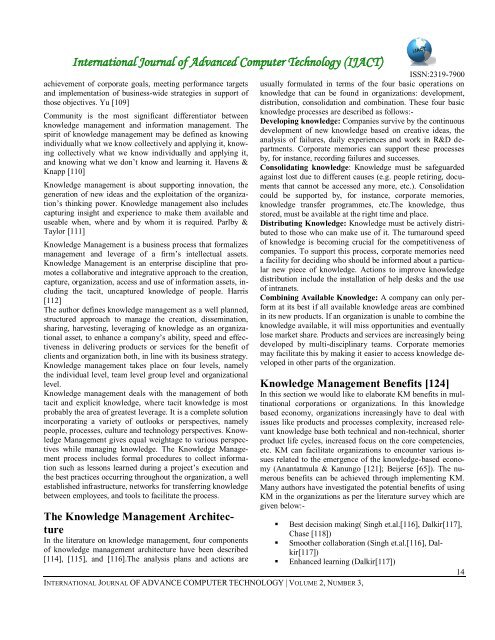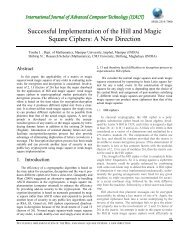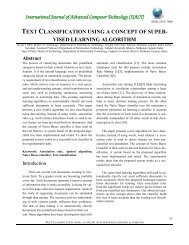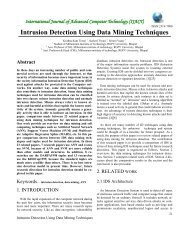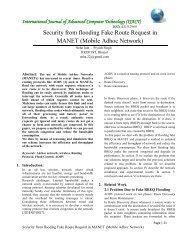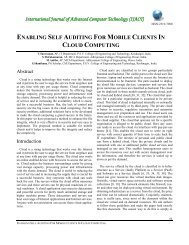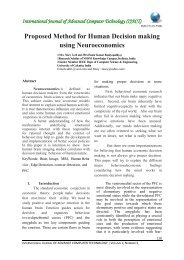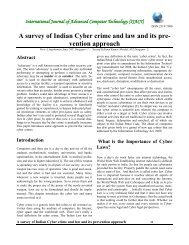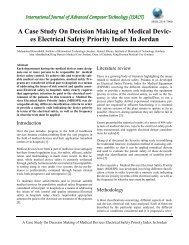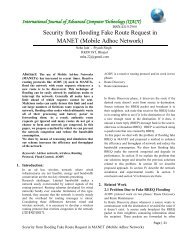A Literature Review - International Journal of Advanced Computer ...
A Literature Review - International Journal of Advanced Computer ...
A Literature Review - International Journal of Advanced Computer ...
You also want an ePaper? Increase the reach of your titles
YUMPU automatically turns print PDFs into web optimized ePapers that Google loves.
<strong>International</strong> <strong>Journal</strong> <strong>of</strong> <strong>Advanced</strong> <strong>Computer</strong> Technology (IJACT)achievement <strong>of</strong> corporate goals, meeting performance targetsand implementation <strong>of</strong> business-wide strategies in support <strong>of</strong>those objectives. Yu [109]Community is the most significant differentiator betweenknowledge management and information management. Thespirit <strong>of</strong> knowledge management may be defined as knowingindividually what we know collectively and applying it, knowingcollectively what we know individually and applying it,and knowing what we don‟t know and learning it. Havens &Knapp [110]Knowledge management is about supporting innovation, thegeneration <strong>of</strong> new ideas and the exploitation <strong>of</strong> the organization‟sthinking power. Knowledge management also includescapturing insight and experience to make them available anduseable when, where and by whom it is required. Parlby &Taylor [111]Knowledge Management is a business process that formalizesmanagement and leverage <strong>of</strong> a firm‟s intellectual assets.Knowledge Management is an enterprise discipline that promotesa collaborative and integrative approach to the creation,capture, organization, access and use <strong>of</strong> information assets, includingthe tacit, uncaptured knowledge <strong>of</strong> people. Harris[112]The author defines knowledge management as a well planned,structured approach to manage the creation, dissemination,sharing, harvesting, leveraging <strong>of</strong> knowledge as an organizationalasset, to enhance a company‟s ability, speed and effectivenessin delivering products or services for the benefit <strong>of</strong>clients and organization both, in line with its business strategy.Knowledge management takes place on four levels, namelythe individual level, team level group level and organizationallevel.Knowledge management deals with the management <strong>of</strong> bothtacit and explicit knowledge, where tacit knowledge is mostprobably the area <strong>of</strong> greatest leverage. It is a complete solutionincorporating a variety <strong>of</strong> outlooks or perspectives, namelypeople, processes, culture and technology perspectives. KnowledgeManagement gives equal weightage to various perspectiveswhile managing knowledge. The Knowledge Managementprocess includes formal procedures to collect informationsuch as lessons learned during a project‟s execution andthe best practices occurring throughout the organization, a wellestablished infrastructure, networks for transferring knowledgebetween employees, and tools to facilitate the process.The Knowledge Management ArchitectureIn the literature on knowledge management, four components<strong>of</strong> knowledge management architecture have been described[114], [115], and [116].The analysis plans and actions areISSN:2319-7900usually formulated in terms <strong>of</strong> the four basic operations onknowledge that can be found in organizations: development,distribution, consolidation and combination. These four basicknowledge processes are described as follows:-Developing knowledge: Companies survive by the continuousdevelopment <strong>of</strong> new knowledge based on creative ideas, theanalysis <strong>of</strong> failures, daily experiences and work in R&D departments.Corporate memories can support these processesby, for instance, recording failures and successes.Consolidating knowledge: Knowledge must be safeguardedagainst lost due to different causes (e.g. people retiring, documentsthat cannot be accessed any more, etc.). Consolidationcould be supported by, for instance, corporate memories,knowledge transfer programmes, etc.The knowledge, thusstored, must be available at the right time and place.Distributing Knowledge: Knowledge must be actively distributedto those who can make use <strong>of</strong> it. The turnaround speed<strong>of</strong> knowledge is becoming crucial for the competitiveness <strong>of</strong>companies. To support this process, corporate memories needa facility for deciding who should be informed about a particularnew piece <strong>of</strong> knowledge. Actions to improve knowledgedistribution include the installation <strong>of</strong> help desks and the use<strong>of</strong> intranets.Combining Available Knowledge: A company can only performat its best if all available knowledge areas are combinedin its new products. If an organization is unable to combine theknowledge available, it will miss opportunities and eventuallylose market share. Products and services are increasingly beingdeveloped by multi-disciplinary teams. Corporate memoriesmay facilitate this by making it easier to access knowledge developedin other parts <strong>of</strong> the organization.Knowledge Management Benefits [124]In this section we would like to elaborate KM benefits in multinationalcorporations or organizations. In this knowledgebased economy, organizations increasingly have to deal withissues like products and processes complexity, increased relevantknowledge base both technical and non-technical, shorterproduct life cycles, increased focus on the core competencies,etc. KM can facilitate organizations to encounter various issuesrelated to the emergence <strong>of</strong> the knowledge-based economy(Anantatmula & Kanungo [121]; Beijerse [65]). The numerousbenefits can be achieved through implementing KM.Many authors have investigated the potential benefits <strong>of</strong> usingKM in the organizations as per the literature survey which aregiven below:-INTERNATIONAL JOURNAL OF ADVANCE COMPUTER TECHNOLOGY | VOLUME 2, NUMBER 3,• Best decision making( Singh et.al.[116], Dalkir[117],Chase [118])• Smoother collaboration (Singh et.al.[116], Dalkir[117])• Enhanced learning (Dalkir[117])14


